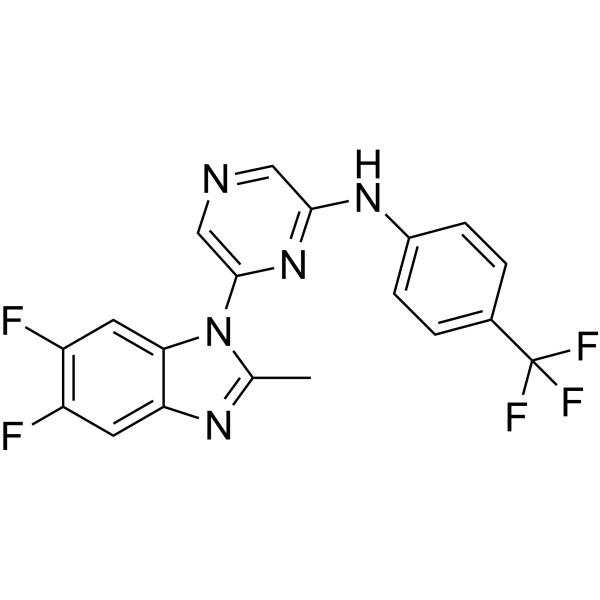| Cas No.: | 1782970-28-8 |
| Chemical Name: | PTC-028 |
| Synonyms: | 2-Pyrazinamine, 6-(5,6-difluoro-2-methyl-1H-benzimidazol-1-yl)-N-[4-(trifluoromethyl)phenyl]-;6-(5,6-difluoro-2-methyl-1H-benzo[d]imidazol-1-yl)-N-(4-(trifluoromethyl)phenyl)pyrazin-2-amine;PTC 028;PTC028;BCP20909;s8662;ZB1588;AK00798850;A16812;6-(5,6-difluoro-2-methylbenzimidazol-1-yl)-N-[4-(trifluoromethyl)phenyl]pyrazin-2-amine;PTC-028;HY-103696;PTC-028?;AC-36334;CCG-268705;BP168106;D80525;AKOS037648938;1782970-28-8;6-(5,6-difluoro-2-methyl-1,3-benzodiazol-1-yl)-N-[4-(trifluoromethyl)phenyl]pyrazin-2-amine;PTC 028;EX-A1647;DA-57208;SCHEMBL16747858;BS-16072;CS-0032942;JEZGPBWIZWPDHP-UHFFFAOYSA-N |
| SMILES: | FC1=C(C=C2C(=C1)N(C1C=NC=C(NC3C=CC(C(F)(F)F)=CC=3)N=1)C(C)=N2)F |
| Formula: | C19H12F5N5 |
| M.Wt: | 405.3241 |
| Purity: | >98% |
| Sotrage: | 2 years -20°C Powder, 2 weeks 4°C in DMSO, 6 months -80°C in DMSO |
| Description: | PTC-028 is an orally bioavailable inhibitor of stem cell factor BMI-1 in ovarian cancer. PTC-028 selectively inhibits cancer cells whereas normal cells remain unaffected. Depletion of BMI-1 by PTC-028 induces caspase-mediated apoptosis[1]. |
| In Vivo: | PTC-028 (15 mg/kg; administered orally twice weekly) caused ~94% (0.169 g) reduction in tumor weight compared to the control (average tumor weight, ~3g) [1]. No obvious toxicity is noted in the animals during therapy experiments as assessed by mean body weight[1]. PTC-028 (10 mg/kg or 20mg/kg; single oral doses) is administrated to the CD-1 mice. The Cmax is reached at both dose levels 1h post dose after which plasma concentrations slowly reduce[1]. Animal Model: Female athymic nude mice with implanted OV90 cells[1] Dosage: 15 mg/kg Administration: Orally administered; twice weekly Result: Caused ~94% (0.169 g) reduction in tumor weight. Animal Model: Female CD-1 mice[1] Dosage: 10 mg/kg or 20mg/kg Administration: Oral administered; single dose Result: Total plasma AUC0-24h were 10.9 and 26.1 μg•h/mL at doses of 10 and 20 mg/kg. The Cmax for PTC-028 at 10 and 20 mg/kg was 0.79 and 1.49 ug/mL, respectively. |
| In Vitro: | PTC-028 (25-500 nM; 48 hours) significantly decreases CP20, OVCAR4 and OV90 epithelial ovarian cancer cells viability. However, in normal ovarian surface epithelial cells (OSE) and fallopian tube epithelial cells (FTE) cells, up to 500 nM treatment with PTC-028 for 48 hours has minimal effect (~18-30% decrease) [1]. PTC-028 (100 nM; 2-12 hours) increases in the phosphorylated BMI-1 species in a time-dependent manner. PTC-028 subsequently reduces BMI-1 in the biochemical functional readout [1]. uH2A is observed up to 12 h with PTC-028 (100 nM) in both CP20 and OV90 cells while total H2A levels remained unchanged [1]. PTC-028 (100 nM; 48 hours) significantly decreases BMI-1. However, PTC-028 decreases the expression of XIAP and RIPK1 while LC3B levels remains unchanged compared to that of the control [1]. Significant cleavage of Caspase 7, Caspase 9 and poly ADP-ribose polymerase (PARP) is observed in PTC-028 (100 nM; 48 hours)[1]. Cell Viability Assay[1] Cell Line: OVCAR4, OV90 and CP20 cells Concentration: 0, 25, 50, 100, 200, 500 nM Incubation Time: 48 hours Result: OVCAR4, OV90 and CP20 cells demonstrated significant dose dependent decrease in cell viability with an IC50 of ~100 nM and ~95% decrease at 500 nM. Western Blot Analysis[1] Cell Line: OV90 and CP20 cells Concentration: 100 nM Incubation Time: 2, 4, 6, 12 hours Result: A time-dependent increase in the phosphorylated BMI-1 species and subsequent reduction in the biochemical functional readout. uH2A was observed up to 12 h while total H2A levels remained unchanged. |






















